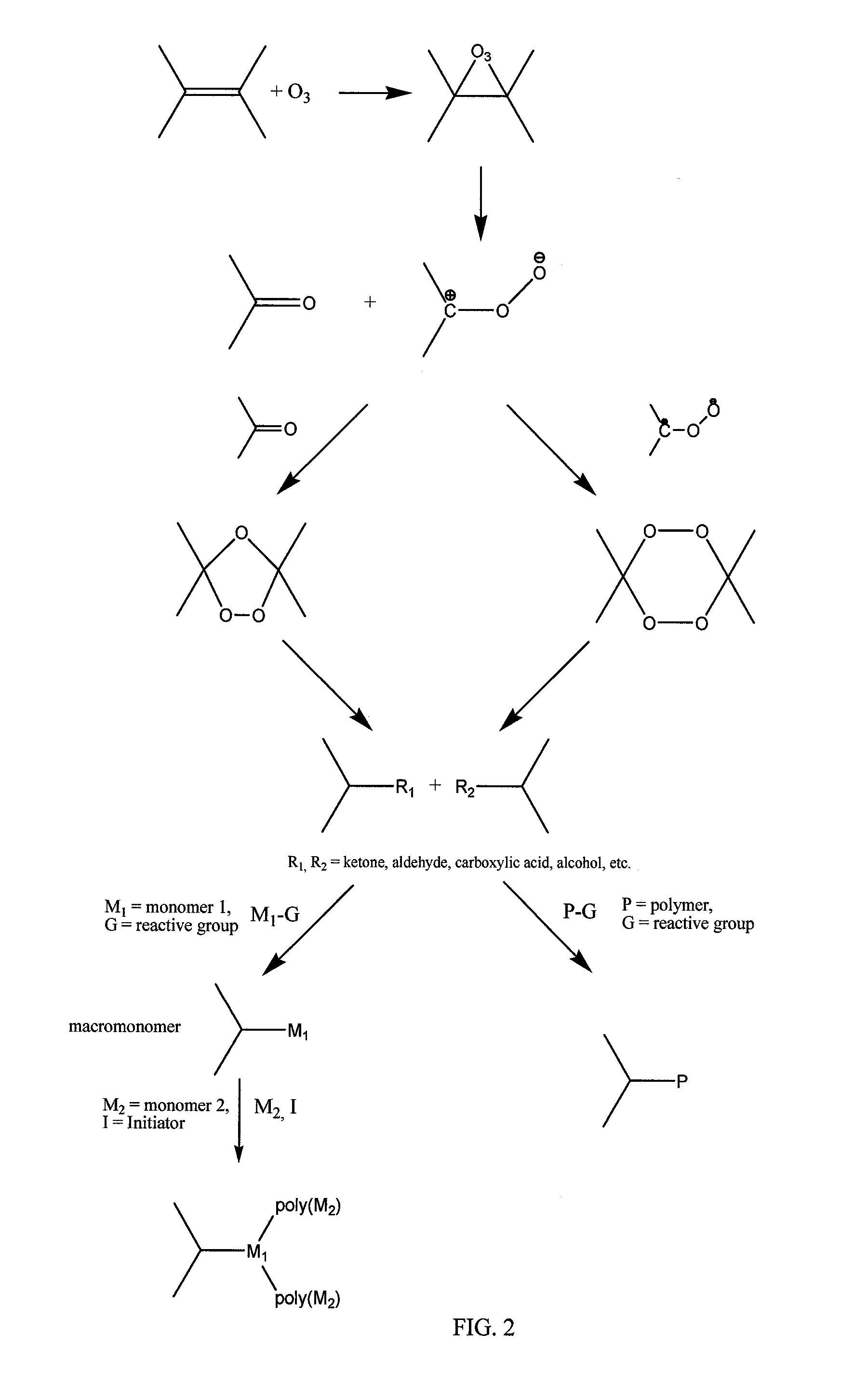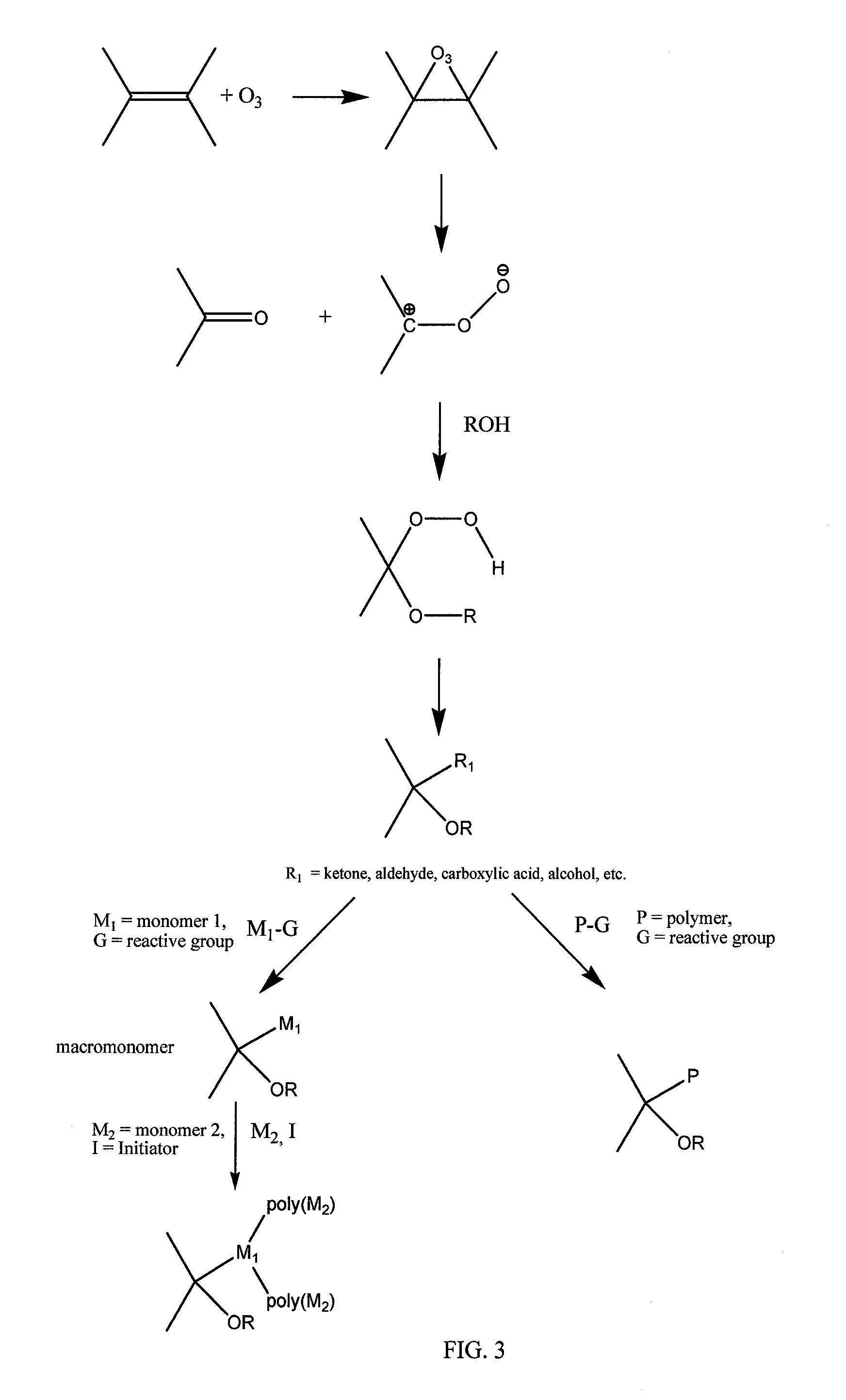Polymer carbon nanotube composites
a carbon nanotube and composite technology, applied in chemical/physical/physical-chemical processes, chemical apparatus and processes, energy-based chemical/physical/physical-chemical processes, etc., can solve the problems of difficult step-up, complex and time-consuming methods, and delicate handling of electrochemical processes/diazonium species for functionalizing carbon nanotubes, etc., to reduce the difficulty and disadvantages
- Summary
- Abstract
- Description
- Claims
- Application Information
AI Technical Summary
Benefits of technology
Problems solved by technology
Method used
Image
Examples
example 1
Preparation of Functionalized Carbon Nanotubes (CNTs-1) by Ozonolysis in a Non-Participating Solvent
[0092]The pristine carbon nanotubes (6 g) were dispersed in chloroform (600 ml) using extensive sonication (Vibracell 75043). Ozonolysis was performed at room temperature using a Trailigaz ozobloc during 8 hours with an ozone flow of 10 g / h followed by an air purge (1 hour). CNTs were filtered, washed three times with 100 ml of chloroform and dried at room temperature under vacuum (20 mmHg). TGA analysis showed a weight loss of about 7 wt. % between 100 and 400° C. that did not appear in TGA analysis of pristine nanotubes. EDX showed an enhancement of the oxygen composition of the CNTs which rose from 2 wt. % to 4.5 wt. % for respectively the pristine CNTs and the ozonolyzed CNTs. FTIR analysis (FIG. 5) exhibited various signals attributed to the expected functions such as esters and carboxylic acid (1040, 1160, 1260 and 1740 cm−1) or alcohol (3400 cm−1). Moreover, DSC analysis showed...
example 2
Preparation of Functionalized Carbon Nanotubes (CNTs-2) by Ozonolysis in a Participating Solvent
[0093]Pristine carbon nanotubes (6 g) were dispersed in ethanol (600 ml) using extensive sonication (Vibracell 75043). Ozonolysis was performed at −45° C. using a Trailigaz ozobloc during 8 hours with an ozone flow of 10 g / h followed by an air purge (1 hour). CNTs were filtered, washed three times with 100 ml of ethanol and dried at room temperature under vacuum (20 mmHg). Functionalized CNTs were stored under inert atmosphere at 4° C. TGA analysis showed a weight loss of about 4.5 wt. % between 100 and 400° C. DSC analysis showed an exothermic transition at about 100° C. due to a thermal decomposition of the hydroperoxide groups. This was confirmed by a second DSC analysis on the sample that did not show any transition.
example 3
Preparation of Functionalized Carbon Nanotubes (CNTs-3) by Ozonolysis in a Gas Phase
[0094]In a fluidized bed reactor, an ozone / air mixture flow was passed through pristine carbon nanotubes (6 g). Ozonolysis was performed at room temperature using a Trailigaz ozobloc during 4 hours with an ozone flow of 6 g / h followed by an air purge (1 hour). TGA analysis showed a weight loss of about 20 wt. % between 140 and 600° C. Functionalized CNTs are used as-synthesized in the following steps (grafting from, through and onto polymerisation) without any further purification or separation step. However, in the case of grafting from polymerisation, ozonized carbon nanotubes have to be dried at room temperature otherwise it is thought that peroxidic and secondary ozonides may decompose prematurely. FTIR analysis exhibited various signals attributed to the expected functions such as esters and carboxylic acid (1040, 1160, 1260 and 1740 cm−1) or alcohol (3400 cm−1). DSC analysis showed an exothermi...
PUM
| Property | Measurement | Unit |
|---|---|---|
| temperature | aaaaa | aaaaa |
| temperatures | aaaaa | aaaaa |
| temperature | aaaaa | aaaaa |
Abstract
Description
Claims
Application Information
 Login to View More
Login to View More - R&D
- Intellectual Property
- Life Sciences
- Materials
- Tech Scout
- Unparalleled Data Quality
- Higher Quality Content
- 60% Fewer Hallucinations
Browse by: Latest US Patents, China's latest patents, Technical Efficacy Thesaurus, Application Domain, Technology Topic, Popular Technical Reports.
© 2025 PatSnap. All rights reserved.Legal|Privacy policy|Modern Slavery Act Transparency Statement|Sitemap|About US| Contact US: help@patsnap.com



